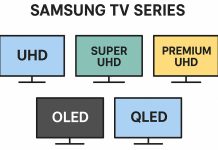In 2015, Samsung introduced the Galaxy A8 — one of the first mid-range models with a metal body. This was an important step for the brand, aiming to combine a premium look with an affordable price. The smartphone quickly gained popularity among users who appreciated its stylish design and well-balanced features.
The Galaxy A8 stood out with its ultra-thin metal body, just 5.9 mm thick. At the time of release, it was one of the thinnest smartphones on the market. The body was made of 6000-series aluminum, giving the device both strength and a premium feel.
It featured a 5.7-inch Super AMOLED display with Full HD resolution (1920×1080 pixels). The screen delivered rich colors and deep blacks, while the wide viewing angles made watching content comfortable. A built-in eye protection mode reduced blue light exposure during extended use.
Reliable Mid-Range Quality
The Galaxy A8 was powered by an octa-core Exynos 5430 processor with a clock speed of 1.8 GHz. Built on a 20nm process, it offered a solid balance between performance and energy efficiency. With 2 GB of RAM, the device handled most everyday tasks with ease, including web browsing, using apps, and playing mid-level games.
The internal storage was 16 GB, expandable via microSD card up to 128 GB. This was sufficient for storing photos, videos, and other files.
The main camera had a 16 MP sensor with phase detection autofocus and an f/2.2 aperture. It produced sharp and detailed photos in good lighting, and acceptable results in lower light thanks to software enhancements and image stabilization. The 5 MP front-facing camera was suitable for selfies and video calls, offering decent image quality for social media use.
Everyday Convenience
A 3050 mAh battery provided a full day of use under moderate load. Fast charging support allowed the battery to be topped up quickly, which was useful for users on the go. A power-saving mode helped extend battery life when needed by disabling background processes and reducing screen brightness.
Out of the box, the Galaxy A8 ran on Android 5.1 Lollipop with Samsung’s TouchWiz interface. The UI was intuitive and offered plenty of customization options. Later, the device received an update to Android 7.0 Nougat, which added features like multi-window mode, improved stability, and better app performance.
The phone also featured a fingerprint scanner integrated into the Home button, LTE Cat.6 support, and in some versions — dual SIM capability. Models released in certain markets came with dust and splash resistance rated IP54.
The Samsung Galaxy A8 (2015) became a strong example of how to combine stylish design, high build quality, reliable performance, and reasonable pricing. Even years after its release, this model remains an attractive choice for users seeking a dependable smartphone with solid core features.





